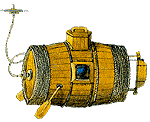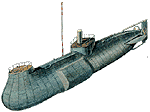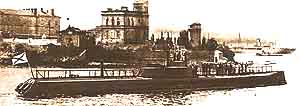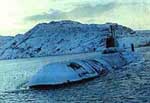| Tell a friend | Print version |
|---|
Those Attacking from under the Dark Deep
It is an extract from a book “The Fleet of the State of Russia. The Roots and Origin of the Russian Navy” written by V.Dygalo.
It is a generally accepted historical fact that the first submarine was built and tested in 1620 on the Thames by a Dutch mechanic and physicist Cornelius van Drebbel. His wooden submarine, covered with oiled leather from the outside, could sail underwater for short distances and was set in motion with oars. Her crew numbered 12 oars-men and 3 officers. According to the chronicles of that time, King Jacob I personally was present at the submarine submergence ceremony. Scientists do not exclude a possibility that van Drebbel had used compressed air or, perhaps, even oxygen. They wrote exactly the following: “This vessel could stay underwater for several hours at the depth of 4-5 meters. Unfortunately, van Drebbel’s death stopped further experiments”. In the year of his death, i.e., 1634, Sarrain Mersenne, a French scientist, mathematician and philosopher, published a book which provided the following generations of submarine constructors with valuable practical recommendations and technical advice. Mersenne, for example, advised them to build such submarines that would resemble fish in their forms and to make both ends of their hulls equally sharp. Mersenne, believed copper, rather than wood, to be the most suitable construction material for those underwater vessels, and he also advised against increasing the size of them.
In 1775, an analogous project was presented by an American inventor Bushnell who, rather wrongly, is often thought to be the designer of the first military submarine.
It was not until 1884 that another Russian inventor S.K. Dzhevetskiy achieved successful results after having equipped the submarine built following his project with an electric engine of 1 horse-power with an innovative electric energy source – accumulator battery. Being put to the tests, the submarine developed a speed of 4 knots going underwater against the Neva River stream. It was the world’s first electric motor submarine.
|
|
|
|
In 1912, the Baltic Shipyards laid down the first diesel submarine of “Bars” type. She proved to be one of the most technically-perfect and reliable submarines of her time. Displacement of those submarines was 650 tons surfaced and 780 tons submerged. All the submarines of Bars type were equipped with two diesel engines which could develop a surface speed of 11.5 knots (21.3 km/h). Her speed submerged, reaching 8.5 knots, was secured by two electric motors. The armament consisted of twelve 450-mm torpedo-tubes (eight of them were Dzhevetskiy lattice systems and four tubular ones), two artillery guns (57-mm and 37-mm) and one machine-gun. Those submarines could submerge 90 meters deep.
Submarines U-19 and U-34, which were built in Germany during this very period, had only four torpedo-tubes (two forward and two aft) and one 88-mm gun.
The main drawback of Bars-type submarines was the absence of water-proof bulkheads which decreased their vitality and floodability parameters. Commission of these submarines in 1915-1917 significantly enhanced the Baltic Sea Fleet operational capabilities.
At the outbreak of the World War I, the Baltic Fleet underwater forces consisted of submarines brigade 98 ships) and underwater training vessels unit (3 ships) mainly equipped with outdated and obsolete submarines.
In 1915-1916, the Baltic Fleet received 7 submarines of Bars type (the Bars/Ounce, the Vepr/Wild Boar, the Volk/Wolf, the Lvitsa/ Lioness, the Panther, the Rys’/Lynx and the Tiger) and 5 submarines of AG type (AG-11, AG-12, AG-14, AG-15, AG-16) bought in America and assembled in Russia. Apart from them, allied England sent to the Baltic Sea ten (two of them were destroyed during the voyage) submarines of “E” and “S” types (E-1, E-8, E-9, E-18, E-19, S-26, S-27, S-32) together with a mother ship the Amsterdam.
Soon, the brigade was re-organized in a submarine division. By the beginning of 1917, it included 7 flotillas with 4-5 ships in each, not to mention English submarines. The first three flotillas were completely equipped with “Bars”-type submarines, while the fourth one – with “AG”-type submarines. Total strength of this division was 40 submarines and a mother ship Tosna.
Thus, submarines as one of the Navy arms demonstrated their might during the WWI. By its end, the Russian underwater forces had more or less established structure as well as operational strategy and tactics.
With the purpose of the German and Turkish ships and transports destruction, Russian submarines actively used torpedo weapons and seldom artillery. Mainly they applied single-torpedo aimed fire method. The first submarine that successfully applied torpedo salvo method was the Gepard (“Cheetah”). 10 August, 1915, off the western coast of Ezel Island, she attacked the German cruiser Lubeck which was escorted by five destroyers and succeeded in destroying her with one of the five torpedoes fired at intervals of several seconds. The Gepard’s crew submerged 20 meters deep after the attack heard a loud explosion.
30 April, 1915, another submarine the Dragon (captain-lieutenant N. Iliinskiy) spotted a German cruiser escorted by several destroyers. The submarine was detected by the enemy and underwent heavy bombardment after which she was chased by the enemy guard-ships. Despite all these, the Dragon’s captain managed to skillfully dodge the fire and set course for approaching and attacking the main target. Having taken up the most advantageous firing position, the captain fired a torpedo and submerged 20 meters deep. The crew of the Dragon clearly heard an explosion. Some time later, on surfacing the periscope depth, Iliinskiy spotted another cruiser, attacked her and forced her to hastily leave the district.
The Russian submariners’ actions made the enemy introduce a convoy system which usually consisted of 12-14 transports; auxiliary vessels, torpedo-boats and armed trawlers were used as guard-ships. Although anti-submarine protection was all-round, our submarine captains, even under such difficult conditions, achieved impressive results. For example, 17 May, 1916, submarine the Wolf (captain-senior lieutenant I. Messer) while operating near the Norchepinsk Bay, sank three German transports of 8 800 tons total tonnage.
During 1915 campaign alone, courageous Russian submariners conducted 78 operational cruises, destroyed 2 enemy cruisers and 16 transports, while the tonnage of the warships and transports, sank by them over two war years, totaled 105 000 tons.
Assessing the Russian submarines operational activity during the World War I, one should bear in mind that the underwater fleet, back in those days, was taking its first steps, but those first steps were already decisive and very promising.
After the Arctic cruise termination, there remained only 12 submarines of “Bars” type, including the famous Panther, in the Baltic Sea Fleet.
On 31 august, 1919, this submarine under the command of A.N. Bakhtin put out to sea in order to conduct operations against the interventionist ships. On reaching the berthing site of the English ships near the Seskar Island from the sunny side, Bakhtin approached the enemy destroyer Vittoria and, firing a double-torpedo salvo, sank her. Having submerged, the captain broke off from the English chase, thus having spent more than 24 hours under water. During this period, the Panther had sailed 75 miles and set up a record for all submarines of that time.
The Panther, commissioned in 1916, can be considered a ship-long-liver. After the 1st of December 1922, she was renamed in the Commissar. Until 1936, she was registered in the Baltic Sea Fleet, and later she was re-qualified into a training vessel. In 1942, she was re-organized into a charging station. In 1955, the Panther was written off from the Navy stock as an obsolete ship.
The formation of the Soviet underwater fleet, as I have already mentioned, began from the construction of the first six submarines of “Decabrist” type which were included in the 1st naval shipbuilding programme of 1926/27-1931/32. The Decabrist was designed in the naval design bureau headed then by a talented constructor B.M. Malinin, a student of prominent naval engineers K.P. Boklevskiy and I.G. Bubnov. Many other outstanding scientists and shipbuilders like A.N. Krylov, P.E. Papkovich and Y.A. Shimansky participated in the process of her construction.
Unlike pre-revolution “Bars”-type submarines, submarines of “Decabrist” type which came to take their place were double-hull just like all the next types of Soviet submarines. Their tactical-technical characteristics were the same as those of foreign analogues. With the displacement of 941/1288 tons, their major dimensions were 76,6 õ 6,4 õ 3,81 m. Diesel-electrical power installation of 2200/1050 horsepower. allowed them to develop a speed of 14/9 knots while their endurance was 3440/135 miles. Submarines of this type were armed with eight 533-mm torpedo-tubes (six were placed in the bow and two in the stern), one 100-mm and one 45-mm guns. Her complement numbered 53 seamen. Subs of “Decabrist” type were commissioned in 1930-1931. In 1933, Soviet shipbuilding industry supplied the fleet with underwater vessels of series II (type L/Leninist”). Apart from powerful torpedo armament, they were equipped with special tubes for laying obstacle mines, thus becoming the first Soviet underwater mine-layers. Their tactical-technical characteristics were similar to those of Decabrist-type submarines with the exception of endurance surfaced (7-11 000 miles). In 1933, the fleets started being equipped with submarines of “Sch” type (“Schuka”/”Pike”), and by 1941 their number increased up to 84 units. The “Schukas” were built and commissioned in series: 1933 – series III (4 units); 1933-1934 – series V (12 units); 1934-1935 – V-bis – 1st series (14 units); 1935-1936 – V-bis-2nd series (13 units); 1936-1939 – series X (32 units) and 1941 – X-bis series (9 units). Their project was worked out by a design bureau headed by B.M. Malinin. Their performance characteristics were gradually changed from series to series in the direction of diesel engines capacity increase, endurance decrease and submerged speed increase. Their armament (four torpedo-tubes forward and two torpedo-tubes aft, two 45-mm guns) remained unchanged. The last series of “Sch”-type submarines was of 584/700 tons displacement; their major dimensions were 58,8 õ 6,4 õ 4,0 m; power installation capacity was 1600/800 h.p.; speed reached 14/8 knots and endurance of 4500/100 miles.
The most popular and widely-spread submarines in the Navy were those of “M” type –“Malyutka” series VI and VI-bis – which were built under the direct leadership of constructors A.N. Asafiev and P.I. Serdyuk.. Their construction started in 1934. In 1940, they were replaced by subs of “M” type (“Malaya” series XII and XV). The last subs of series XV were put into operation in 1944. In comparison with “malyutkas”, their displacement increased twice and reached 283/350 tons which helped to install four torpedo-tubes instead of two as it used to be on the submarines of the first series. Their power installation capacity was 920/960 h.p. while their speed was increased by 15.5./9 knots with endurance of 3000/85 miles.
Let us leave the past on the conscience of our politicians and admit the fact that in the process of the per-war submarines and other ships construction our country collaborated with Germany. Diesel engines for submarines of Decabrist type were bought in Germany. German engineers provided technical assistance to us in terms of design and construction of “S”-type submarines (“Srednyaya”/Medium-size) which had been built since 1936 and throughout the war. Two series of those submarines (IX and IX-bis) numbered 34 units. B.F. Kritsky, naval engineer and Rear Admiral, took an active part in “S” submarines construction. These submarines displacement totaled 837/1073 tons with major dimensions of 77,7 õ 6,4 õ 4,0 m,; power installation capacity – 4000/1100 h.p.; they were able to develop a speed of 19.5/9.0 knots with endurance of 8200/135 miles. Their armament included four torpedo-tubes forward and two torpedo-tubes aft together with one 100-mm gun.
It is worth paying special attention to our famous submarine of “K” type (“cruising”). Her project was worked out in detail in 1935. Her chief designer and constructor was M.A. Rudnitsky, the head of the underwater navigation department with the Scientific-Research Institute of Naval Shipbuilding.
In terms of her tactical-technical characteristics, the submarine designed by Rudnitsky became a prototype of our ocean-going submarines built after the war. A lot of technical innovations were introduced on this submarine, namely automatic surfacing and submerging remote control system; reliable powerful radio station that secured sustainable connection, if surfaced, from the remote ocean areas. In the 1939 acceptance act of the lead submarine K-1, the State Commission registered the following: “The submarine meets the highest technical standards and in terms of her tactical elements and major characteristics excels all the existing foreign analogues, especially in terms of armament and speed parameters”.
Indeed, her armament included ten torpedo-tubes (six torpedo-tubes forward and four torpedo-tubes aft), two 100-mm and two 45-mm guns as well as two machine-guns. She was capable of taking on board up to 20 mines. Her speed, both surfaced and submerged, was remarkably high – 21.1/10.3 knots while endurance was very well matched for underwater cruisers – 14040/176 miles. With displacement of 1487/2102 tons, the K-1’s major dimensions were 97,7 õ 7,4 õ 4,1 m; her complement numbered 62 men. She was commissioned on 16 December 1939, and she joined the Northern Fleet on 6 August 1940.
By the beginning of the Great Patriotic War, the USSR Navy could boast of 212 submarines. Their impressive technical parameters, professionally-trained, highly-skilled and staunch crew members made our submarines a formidable force during the war days.
During the GPW, our submarines, forcing their way through artificial obstacles, would fire gunshots thus informing how many enemy ships they had sunk. Meanwhile those waiting for them on the shore were preparing a festive dinner with the corresponding number of roast sucking-pigs. That way, new fleet traditions were created. A momentous event in the history of our underwater forces was the order ¹ 170 of 12 July 1942, issued by the People’s USSR Navy Commissar Admiral Nickolay Gerasimovich Kuznetsov, which declared the introduction of the “Breastplate for submarine captain”. Thus the tradition of wearing this special breastplate for Navy submarine officers, which had been introduced for the first time by the Naval Order of 1909, was re-established. The new version of the breastplate – a delicate silver submarine with a ruby star under the deckhouse fixed on the right pocket of the tunic of those captains distinguished themselves in the battles against fascists – has become a unique decoration and a symbol of professionalism and unsurpassed naval skill of those captains who were committed to take command of soviet submarines.
On 15 August 1987, the USSR Defence Minister’s order ¹ 233 declared “the captain’s submarine to be called a breastplate “Captain of the ship””. In accordance with this regulation, only submarine captains on taking command of the ship following the recommendation for this award were to be decorated with this distinctive decoration. The decoration ceremony is conducted with all due military honours as it was established during those difficult years of the Great Patriotic War. The same order of the People’s Navy Commissar introduced another “Decoration for enemy ships sinking”.
Our submariners have always piously revered another old naval tradition which goes as follows: “One for all and all for one!” For no other type of ships is this tradition so relevant and true to life as for submarines where the life and success of the entire crew depends on the actions of every single sailor, sergeant major, officer or warrant officer. Nowhere else can there be the same extent of equality of fates and responsibility of the staff as on submarines where there are only two possibilities during operational voyages: either they all win together or die together. A bright example of this simple truth is the operational voyage of the Black Sea Fleet submarine M-32.
In June 1942, this submarine under the command of Lieutenant-Captain N.A. Koltypin would deliver ammunition and petrol to besieged Sebastopol. One day they failed to get unloaded before dawn and had to submerge in the harbour and stay there for 16 hours waiting for the night to come. To their horror, the driving ballast tank leaked petrol fumes into the inner compartments. The crew members started fainting. Of all the crew only the head of the motor-mechanic brigade senior sergeant N.K. Pustovoytenko was able to stand on his feet. When the clock showed that it was already dark on surface, he tried to bring the captain and mechanic into conscience but his efforts were in vain – they badly needed catch a breath of fresh air. Then Pustovoytenko, with great difficulty, managed to surface the submarine on his own and open the deck-house hatch after which the strong wing and current started carrying the M-32 right on the coastal rocks. Pustovoytenko took the captain to the captain’s bridge, left him there in the open air and went down to the central station. He on his own did the work of the entire crew: prepared the compartment for ventilation, started up ventilators, made the main motor control station ready for action. Meanwhile, the captain, mechanic and some other crew members came to their senses. All together they were able to start up the engine, take the submarine off the rocks and put out to sea.
This example proves that good knowledge of all the submarine mechanisms and devices and the way they operate along with competent actions of one member of the crew helped to save the lives of the seamen and keep the ship intact.
The final period of the war was marked by very impressive and effective actions of the Baltic Sea Fleet submariners. On 30 January 1945, off the Danzig Bay, the S-13 under the command of Captain Third Rank A.I. Marinesko attacked and sank the fascist liner Wilhelm Gustloff of 24 484 tons displacement. Ten days later, the S-13 torpedoed another German transport the General von Steuben of 14 680 tons displacement. Both vessels carried some 10000 German soldiers and officers on their boards including 1300 officers and seamen of the fascist submarines as well as a huge number of military machinery, equipment and other valuable property. Unfortunately, Marinesko’s heroic exploit was appreciated at its rue value very late – it was not until 1990 that he was posthumously decorated with the Hero of the Soviet Union. A tremendous, fantastic success accompanied the crew of the K-52 under Captain Third Rank I.V. Travkin during the last months of the war. Four months before the long-awaited Victory, this submarine destroyed six enemy transports and one guard-ship.
The Soviet submariners acted so bravely and selflessly against the enemy transports loaded with troops and military machinery that they successfully fulfilled all the tasks which had been given our seaside army flanks by the Headquarters. Over the final period of the GPW, our submarines sank 26 transports of total displacement of 107 288 tons and one warship.
In addition to enemy ships and transports destruction, our submarines would also lay mine fields in the enemy territorial waters, conduct reconnaissance operations, transport people cargoes and fuel. While fulfilling various kinds of tasks, even those which did not fall under their direct duty, the submarines crews always displayed their adherence to the military oaths and high professionalism.
Our Motherland highly appreciated the heroic deeds performed by our submariners during the Great Patriotic War. Twenty three submarines were awarded with the Order of the Red Banner; twelve subs were named the Guards submarines and four Northern Fleet submarines (D-3, S-56, Sch-402 and M-172) were awarded with the Guards’ banner and the Order of the Red Banner. Thousands of submariners were decorated with the highest government awards while 20 most courageous of them became the Heroes of the Soviet Union.
The first post-war Soviet submarines construction period is characterized by construction of underwater ships with improved performance characteristics (as compared to the Great Patriotic War subs). Apart from cruising capacity, endurance and submergence capacity improvement, surface and submerge speed, number of torpedo-tubes and, of course, displacement were significantly increased. However, their power installations still remained diesel-electric. Various experiments on integrated engine submarine construction had been conducted; a pilot submarine with this type of power installation had been designed but no further impulse was given to this branch of submarine power engineering.
During this period submarines of the two main types, se-going and ocean-going (with increased cruising capacity and endurance) were built. Ocean-going submarines sailed not only the neighboring seas but the most distant water areas of the World Ocean. By that time, several underwater ships had already been armed with ballistic and cruise missiles. However, even those latest ocean-going submarines had shortcomings the main of which were their inability to stay submerged for long periods of time and maneuver at high speed as well as the necessity to recharge their storage batteries and replenish high-pressure air supply using snorkel equipment (a special device securing diesel functioning under water) or surfacing.
During the post-war period, the USA together with NATO countries launched a global nuclear-missile system. Being put in such conditions, the Navy underwater forces were given absolutely new tasks – destruction of enemy nuclear-powered missile carriers with the purpose of preventing them from delivering nuclear-missile attacks on our country; return nuclear-missile attacks targeting his strategic objectives; destruction of his aircraft-carriers and other important surface ship forces as well as anti-submarine forces, landing troops and convoys both in the ocean and at their bases. These determined the purpose of the new submarines as well as the nature of the tasks to be fulfilled by them and a general trend of the Navy underwater forces development.
Starting from the middle of the 1950th, a new era in the Navy development was initiated, namely the formation of the ocean nuclear-missile fleet and, first of all, the construction of nuclear-powered torpedo submarines and, later, missile-carrying submarines and strategic nuclear-missile systems. In due course, the underwater vessels construction was divided into two key branches.
The first one included strategic submarines intended for delivering nuclear-missile attacks on the enemy’s most important military-economic objectives. Such submarines were armed with long-range “ship-to-surface” ballistic or cruise missiles with nuclear warheads and torpedoes for self-defence.
The second branch concentrated on the so-called multi-purpose submarines meant for destroying enemy nuclear-powered underwater missile-carriers, surface ships and transports as well as for reconnaissance and guard operations. Multi-purpose submarines incorporate various types of submarines which are armed with “ship-to-ship” missiles, torpedoes and subsurface-to-subsurface missiles. They are also capable of laying mines using their torpedo-tubes.
|
In July 1962, the nuclear-powered submarine Leninsky Komsomol under the command of Captain Second Rank L.M. Zhiltsov sailed under the ice to the North Pole. One year later, in September 1963, the complement of the submarine under Captain Second Rank Y.A. Sysoev surfaced right in the North Pole and hoisted our National flag and ensign above the ice-hummocks. In February-March 1966, several nuclear-powered submarines under the command of Rear Admiral A.I. Sorokin circumnavigated the globe.
|
One of the latest trends in the Navy development of the most developed countries has been a further build-up of strategic potential focusing, first and foremost, on modification of the underwater nuclear-missile forces which are the basis of the Fleet striking power.
In terms of arms and Armed Forces development, our country is switching over to an entirely new military doctrine based on the principle of “sensible sufficiency” as far as country defence is concerned.







 Submarines in the Russian Imperial Navy
Submarines in the Russian Imperial Navy

 Mikhail Nikolaevich Beklemishev
(1858-1913)
Mikhail Nikolaevich Beklemishev
(1858-1913)
 Ivan Grigorievich Bubnov
(1872-1919)
Ivan Grigorievich Bubnov
(1872-1919)
 Underwater mine-layer the Crab
(1915)
Underwater mine-layer the Crab
(1915)


